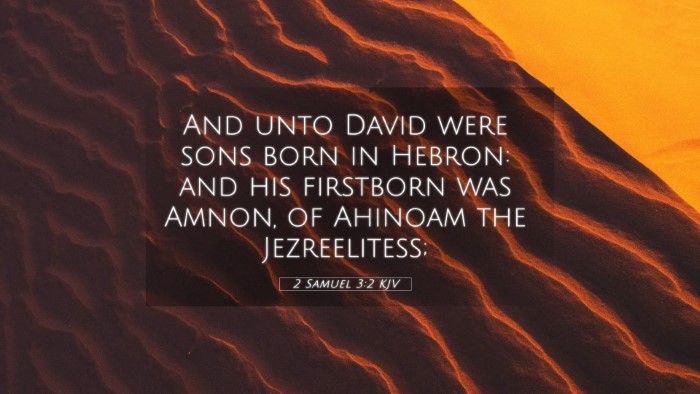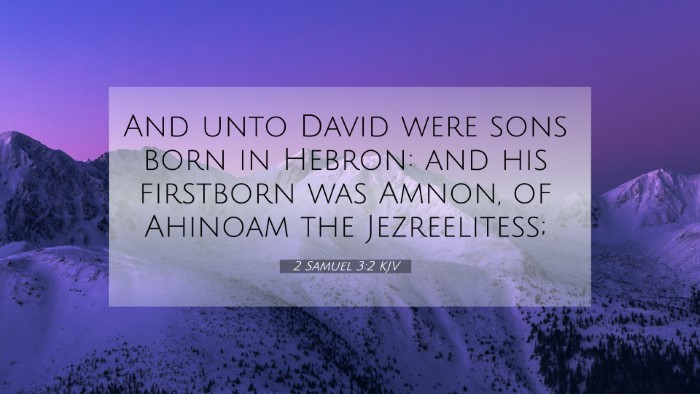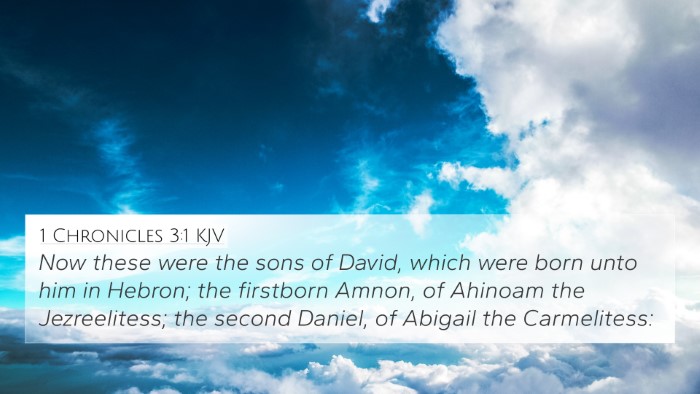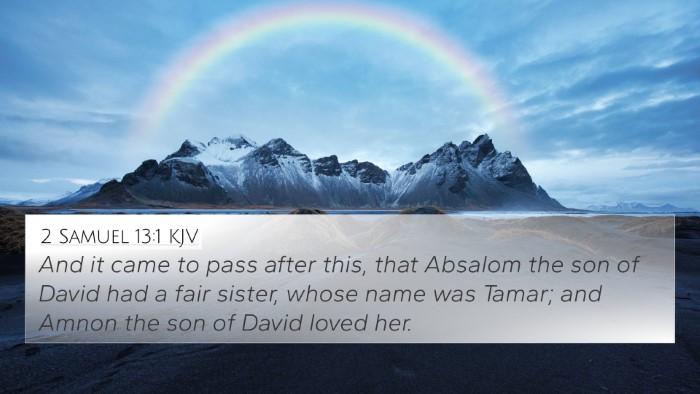Understanding 2 Samuel 3:2
Verse: "And unto David were sons born in Hebron: and his firstborn was Amnon, of Ahinoam the Jezreelitess;" (2 Samuel 3:2, KJV)
Meaning and Commentary
This verse marks the beginning of the account of David's sons born during his reign in Hebron. It highlights the significance of lineage and the establishment of David's house.
Insights from Public Domain Commentaries
-
Matthew Henry:
Henry emphasizes the importance of acknowledging the sons of David as a link in the covenantal promise made to him. He notes the implications of each son's birth, particularly Amnon, as the firstborn, projecting the continuation of David's legacy.
-
Albert Barnes:
Barnes provides additional context by explaining the significance of the names and mothers of David's children, suggesting that they represent various alliances and relationships within Israel. This portrayal illustrates the dynamics within David's kingdom and family, hinting at future conflicts arising from these relationships.
-
Adam Clarke:
Clarke focuses on the historical aspect, contextualizing this moment within the timeline of Israel's monarchy. He describes Hebron as a strategic location for David's reign and a foundational period for his rule, significant for the unification of tribes behind him.
Cross-References and Thematic Connections
This verse can be cross-referenced with several important biblical texts that enhance our understanding of the themes presented:
- 1 Chronicles 3:1-4: This passage provides a genealogy of David's sons, reinforcing the significance of Amnon and his place in David's lineage.
- 2 Samuel 5:13: This verse speaks about David's further sons and the expansion of his household, demonstrating the growth of his lineage.
- Psalm 51:5: David's acknowledgment of sin serves as a backdrop to the flaws that would mark his legacy, indicating issues that extend beyond this particular family line.
- Genesis 49:10: Jacob’s prophecy about Judah ties into David's lineage, emphasizing the importance of David's role as a leader of Israel.
- Matthew 1:6-16: The genealogy of Jesus in the New Testament connects to David's lineage and reiterates the importance of his house in God's redemptive plan.
- 2 Samuel 12:10-11: Highlighting the consequences of David's actions, this passage addresses the strife within David's family, setting the stage for the roles of his sons.
- Luke 3:31: This verse traces Jesus’ lineage back to David, affirming the enduring significance of David's family line in the New Testament covenant.
Importance of Cross-Referencing
Cross-referencing biblical texts is essential for a comprehensive understanding of scriptural meaning. Thematic connections between verses enable scholars and believers alike to explore deeper spiritual truths, enhancing the study process:
- Using a bible concordance can help in identifying links and themes across the Scriptures.
- The bible cross-reference guide serves as a tool for navigating through complex ideas swiftly.
- Understanding these connections supports sermon preparation by providing relevant scriptures that resonate with each other.
How to Use Bible Cross-References
For those interested in how to identify connections between passages, consider the following methods:
- Utilize a structured bible cross-reference system that categorizes verses by themes and topics.
- Engage in a cross-reference bible study to compare and analyze related passages, revealing deeper meanings.
- Employ comprehensive bible cross-reference materials for an in-depth examination of specific themes.
Conclusion
The study of 2 Samuel 3:2 presents a rich tapestry of themes related to legacy, family dynamics, and God's unfolding plan through David's lineage. By understanding the implications of this verse, we can appreciate the interconnectedness of scripture and cultivate a more profound understanding of God's narrative through cross-referencing biblical texts.






